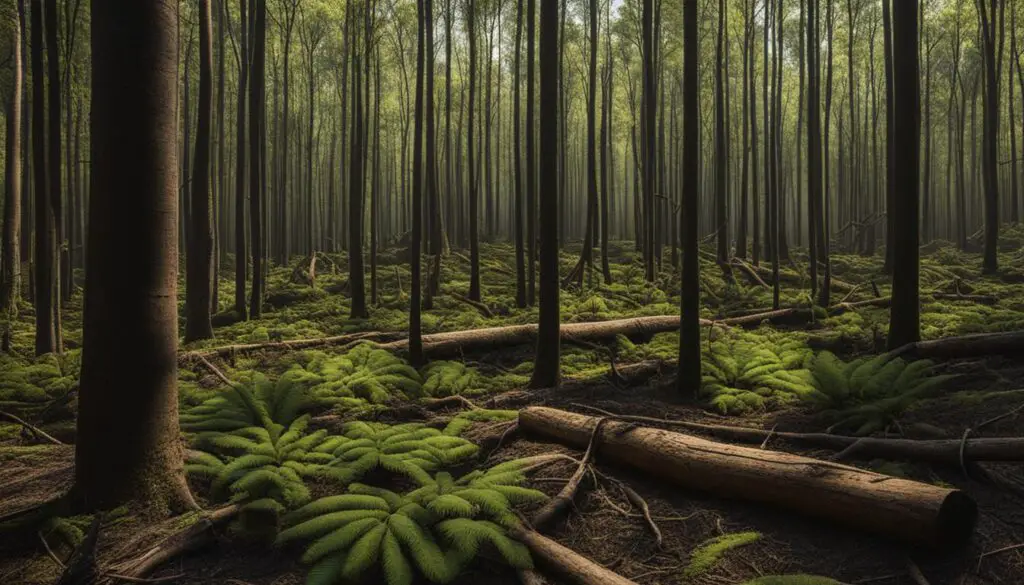Trees are not just beautiful and majestic; they also play a crucial role in sustaining life on Earth. One of their primary functions is oxygen production. Have you ever wondered – do trees produce oxygen? The answer is a resounding yes! Trees are nature’s oxygen factories, continuously converting carbon dioxide into breathable air through a process called photosynthesis.
Photosynthesis is the remarkable process by which trees and other plants use sunlight, water, and carbon dioxide to produce glucose (energy) and oxygen. In this process, trees absorb carbon dioxide from the atmosphere through their leaves and release oxygen, a life-sustaining molecule, back into the air.
The importance of trees in oxygen production cannot be overstated. They are responsible for generating approximately 30% of the world’s oxygen supply. This means that every breath you take owes a debt of gratitude to the vast forests and green spaces that blanket our planet.
Key Takeaways:
- Trees are essential contributors to oxygen production on Earth through the process of photosynthesis.
- Photosynthesis allows trees to convert carbon dioxide into breathable oxygen.
- Trees generate approximately 30% of the world’s oxygen supply.
- Forests and green spaces play a critical role in maintaining breathable air for all living organisms.
- Protecting and preserving existing forests is crucial for ensuring a sustainable oxygen supply and mitigating climate change.
Understanding Trees’ Emissions and Their Effects on Climate
Trees and other plants play a crucial role in the production of oxygen. But did you know that they also release volatile organic compounds (VOCs) into the atmosphere? These VOCs react with ozone and other chemicals, forming secondary organic aerosols (SOAs). While the primary purpose of trees is to generate oxygen, their emissions have significant effects on weather and climate processes, including cloud formation.
Research conducted by the Department of Energy’s Office of Science has shed light on the relationship between VOCs and the resulting SOAs. These studies contribute to our understanding of how trees contribute to oxygen supply and the overall impact of trees on climate dynamics.
By comprehending the intricate connection between tree emissions and atmospheric processes, we can better appreciate the multifaceted role trees play in oxygen production and climate regulation.
Image:
The Importance of Forest Restoration
Forest restoration plays a crucial role in maintaining oxygen levels and combating climate change. According to the first-ever study on global tree restoration potential, there is enough suitable land to increase the world’s forest cover by one-third without affecting existing cities or agriculture. This presents an opportunity to significantly contribute to oxygen production and reduce carbon dioxide levels in the atmosphere.

Restoring forests can have a profound impact on oxygen levels as trees are known for their ability to absorb carbon dioxide and release oxygen through the process of photosynthesis. By increasing the world’s forest cover, we can enhance the oxygen supply and mitigate the effects of climate change.
It is important to note that the process of forest restoration takes time. However, the benefits are long-lasting and far-reaching. By protecting existing forests and reducing carbon emissions from human activities, we create an environment that fosters the growth of new trees and ensures their ability to contribute to oxygen production.
Forest restoration not only helps in oxygen production but also provides numerous additional benefits. Restored forests support biodiversity by providing habitat for various plant and animal species. They also serve as natural carbon sinks, helping to reduce the concentration of greenhouse gases in the atmosphere.
The Role of Forest Restoration in Oxygen Production:
| Benefits of Forest Restoration | Impact on Oxygen Levels |
|---|---|
| Increased forest cover | Enhanced oxygen production through photosynthesis |
| Reduced carbon dioxide levels | Improved air quality |
| Habitat restoration for wildlife | Promotion of biodiversity |
| Creation of natural carbon sinks | Contribution to climate change mitigation |
The Role of VOCs in Forest Ecosystems
Trees are not only essential for oxygen production but also release hundreds to thousands of volatile organic compounds (VOCs) into the air. These VOCs easily evaporate and contribute to the overall chemical composition of the atmosphere. VOCs emitted by trees can undergo reactions with other chemicals in the atmosphere, leading to the formation of secondary organic aerosols (SOAs). These aerosols have a significant impact on climate processes and ecosystem dynamics in forested regions.
The production of VOCs in trees is influenced by various factors such as season, tree species, leaf age, and environmental conditions. Different tree species emit different types and quantities of VOCs, contributing to the diversity of chemical compounds present in forest ecosystems. Understanding and studying VOC emissions is crucial for improving climate models and accurately assessing the role of trees in oxygen production and climate regulation.
Research has shown that VOCs emitted by trees can promote cloud formation and affect the Earth’s energy balance. The interactions between VOCs and other atmospheric components play a key role in the formation of aerosols, which can scatter light and heat, influencing weather patterns and climate processes. By studying VOC emissions and their impacts, scientists gain valuable insights into the intricate relationships between trees, the atmosphere, and the overall health of forest ecosystems.
“Research Findings on VOCs and SOAs”
Through extensive research efforts, scientists have made significant progress in understanding the role of volatile organic compounds (VOCs) and their transformation into secondary organic aerosols (SOAs) in the atmosphere. Findings from studies such as the GoAmazon project have provided invaluable data on VOC emissions and their intricate interactions with human-made pollution and atmospheric processes. These research endeavors have contributed to the advancement of climate models and enriched our understanding of the impact of VOCs and SOAs on climate change and oxygen supply.

Field and laboratory studies have shed light on the complex processes involved in VOC emissions from trees and their subsequent conversion into SOAs. These investigations have revealed how VOCs react with chemicals in the atmosphere, forming SOAs that have far-reaching consequences for weather patterns and climate dynamics. By examining the behavior of VOCs under various environmental conditions, researchers are refining climate models to accurately represent the influence of tree emissions on atmospheric composition and oxygen production.
The multifaceted nature of VOCs and SOAs necessitates a comprehensive understanding of their behavior and impact on the environment. Both natural and anthropogenic sources contribute to the VOC emissions that shape atmospheric chemistry and climate patterns. By examining the interplay between VOCs, human-made pollution, and atmospheric processes, scientists can develop more precise models to assess the consequences of VOC emissions and SOA formation on climate change and oxygen availability.
| VOCs and SOAs | Climate Models |
|---|---|
| VOC emissions contribute to the formation of secondary organic aerosols (SOAs). | Research on VOCs and SOAs enhances climate models and their ability to accurately depict atmospheric processes and the impact of tree emissions on climate change. |
| VOCs from both natural and anthropogenic sources play a complex role in atmospheric chemistry. | Advanced climate models incorporate data on VOC emissions and their impact on SOA formation, providing insights into the influence of tree emissions on oxygen supply. |
| Understanding the behavior of VOCs and their transformation into SOAs aids in comprehending climate change processes. | Precision climate models help refine our understanding of tree emissions’ effect on climate dynamics and oxygen generation. |
The Impact of Trees on the Atmosphere
When it comes to the atmospheric impact of trees, their emissions and the formation of secondary organic aerosols (SOAs) play a crucial role. These SOAs have a significant influence on various atmospheric processes, affecting the overall composition and behavior of the atmosphere.
One of the key impacts of tree emissions and aerosols is their ability to influence the amount of sunlight the atmosphere absorbs. By scattering and absorbing light, these particles can alter the radiative balance of the Earth, ultimately impacting climate and temperature patterns.
Furthermore, tree emissions and aerosols have been found to affect cloud formation. Aerosols can act as cloud condensation nuclei, influencing cloud droplet formation and properties. This, in turn, has implications for precipitation patterns and regional climate variability.
Understanding the interactions between tree emissions and aerosols is critical for accurate climate modeling. By incorporating the effects of these particles, scientists can better assess the overall impact of trees on atmospheric processes and climate dynamics.
The image above illustrates the complex relationship between trees, their emissions, and the atmosphere. Through their interactions with aerosols, trees have the potential to significantly influence our planet’s climate and weather patterns.
The Potential of Forest Restoration
The study on global tree restoration potential highlights the immense benefits and opportunities that forest restoration offers in combatting climate change and promoting sustainability. Reforestation efforts have the potential to not only offset nearly 100 years of carbon emissions but also to significantly reduce carbon dioxide levels in the atmosphere, contributing to a healthier planet.
Forest restoration goes beyond carbon reduction and plays a crucial role in preserving biodiversity and protecting valuable ecosystems. By restoring forests, we create habitats for wildlife, support local communities, and foster a more sustainable future for generations to come.
Here are some key benefits of forest restoration:
- Carbon Reduction: Restoring forests helps capture and store carbon dioxide from the atmosphere, making a significant contribution to global efforts in reducing greenhouse gas emissions.
- Biodiversity Protection: Forests provide homes and habitats for countless plant and animal species, promoting biodiversity conservation and preserving delicate ecosystems.
- Wildlife Habitat: Reforestation efforts create essential habitats for a diverse range of wildlife, allowing them to thrive and maintain their population levels.
- Soil Conservation: Trees help prevent soil erosion, stabilize slopes, and improve soil fertility, ensuring sustainable land use and agricultural practices.
- Water Management: Forests play a crucial role in regulating water cycles, promoting water filtration, reducing flood risks, and ensuring a sustainable supply of clean water.
- Socioeconomic Development: Forest restoration projects create employment opportunities, empower local communities, and contribute to sustainable economic growth.
Forest restoration is widely recognized as one of the most effective climate change solutions available today. By harnessing the full potential of tree planting initiatives, we can make a significant and lasting impact on carbon reduction, biodiversity conservation, and the overall health of our planet.
Challenges and Opportunities in Forest Restoration
The task of restoring forests brings forth both challenges and opportunities. While there is enough suitable land for forest restoration, the availability diminishes as global temperatures rise due to climate change. This poses a significant obstacle to restoration efforts, particularly in tropical regions where these temperature increases are more pronounced. Forest restoration initiatives must address and overcome these challenges to ensure the successful revitalization of our forest ecosystems.
However, certain countries have identified as forest restoration hotspots, showcasing a promising potential for reforestation due to the removal of their existing forests.
| Forest Restoration Hotspots | Existing Forest Removal |
|---|---|
| Russia | Large-scale logging |
| USA | Timber extraction |
| Canada | Clear-cutting operations |
| Australia | Wildfires |
| Brazil | Deforestation for agriculture |
| China | Urbanization and infrastructure development |
Identifying these forest restoration hotspots opens up opportunities to focus resources and efforts in these areas, maximizing the chances of successful reforestation. However, it is essential to address the specific challenges faced in these regions, such as local socio-economic factors, land ownership rights, and resource availability. By understanding and overcoming these obstacles, we can make significant progress in restoring and preserving our forests for future generations.

The Role of Indigenous Peoples and Local Communities
Indigenous peoples and local communities play a crucial role in the protection and sustainable management of forests, including those with significant indigenous land tenure. Recognizing their rights and involving them in forest restoration efforts is key to ensuring the long-term preservation of forest ecosystems and the valuable services they provide, such as oxygen production and carbon sequestration.
Indigenous peoples have a deep connection to the land and possess invaluable traditional knowledge about forest ecosystems. Their holistic approach to forest management, which combines social, cultural, and environmental considerations, can contribute to effective forest restoration and conservation strategies. By including indigenous peoples and local communities in decision-making processes, their perspectives, expertise, and traditional practices can be harnessed to achieve a balance between sustainable development and forest protection.
The involvement of indigenous peoples and local communities also fosters a sense of ownership and responsibility over the forests. When local communities have a stake in the conservation and restoration efforts, they are more likely to actively participate in monitoring, protection, and sustainable resource use. This engagement can lead to improved livelihoods, increased resilience to climate change, and enhanced well-being for indigenous peoples and local communities.
“The active participation of indigenous peoples and local communities in forest restoration is vital to ensure effective conservation and sustainable management of forests.”
| Country | Indigenous Land Tenure | Forest Protection Measures |
|---|---|---|
| Canada | 24% of land is Indigenous-owned | Collaborative management agreements |
| Brazil | 13% of land is Indigenous-owned | Indigenous territorial rights |
| Australia | 49% of land is Indigenous-managed | Indigenous Protected Areas |
| New Zealand | 40% of land is Maori-owned | Co-governance arrangements |
| Indonesia | 11% of land is Indigenous-owned | Recognition of customary land rights |
The Future of Trees and Oxygen Production
As climate change continues to pose significant challenges, the future of trees in oxygen production and climate change mitigation becomes even more crucial. Trees play a vital role in maintaining the balance of oxygen supply and reducing carbon dioxide levels, contributing to the overall health of our planet’s ecosystems.
To ensure a sustainable future, it is essential to protect existing forests from deforestation and degradation. Forests act as natural carbon sinks, absorbing atmospheric carbon and storing it within their biomass. By preserving and managing these forests responsibly, we can help mitigate climate change and maintain oxygen production.
Implementing sustainable land management practices is another key aspect of securing the future of trees and oxygen production. By promoting responsible forestry, agroforestry, and reforestation techniques, we can increase the resilience of our forests and enhance their capacity to absorb carbon dioxide and generate oxygen.
Reforestation efforts play a critical role in restoring degraded forests and expanding forest cover. Through strategic planting initiatives, we can replenish our forests, provide habitat for wildlife, and contribute to oxygen production. Reforestation also offers opportunities for local communities, fostering economic growth and promoting environmental stewardship.

By investing in the future of trees and oxygen production, we can mitigate the effects of climate change and ensure a sustainable environment for future generations. The preservation of existing forests, the implementation of sustainable land management practices, and the increase in reforestation efforts are vital steps to safeguarding our planet’s ecosystems and securing a healthier future.
Conclusion
Undoubtedly, trees play a vital role in our planet’s oxygen production. Through the process of photosynthesis, trees convert carbon dioxide into breathable air, ensuring the availability of oxygen for all living organisms. However, their significance goes beyond oxygen supply. Forest restoration efforts are crucial in mitigating climate change by reducing carbon emissions and maintaining a healthy balance in our ecosystems.
Understanding the complex interactions between tree emissions, atmospheric processes, and climate models is essential for comprehending the full impact of trees on our environment. Through scientific research and data analysis, we can enhance our knowledge and appreciation for the role trees play in sustaining life on Earth. It is through this understanding that we can advocate for tree restoration and conservation, ensuring a greener, healthier future for generations to come.
As climate change poses unprecedented challenges, the importance of tree restoration becomes even more evident. By protecting existing forests and implementing sustainable land management practices, we can contribute to reducing carbon dioxide levels and mitigating the effects of climate change. The preservation of our planet’s forests is not only crucial for oxygen production but also for the overall health of our ecosystems. Through collective efforts and a commitment to tree restoration, we can make a significant impact in combatting climate change and securing a sustainable future.
FAQ
Do trees produce oxygen?
Yes, trees produce oxygen through the process of photosynthesis, where they convert carbon dioxide into breathable air.
How do trees contribute to oxygen production?
Trees release oxygen as a byproduct of photosynthesis, helping to replenish the Earth’s oxygen supply.
How important are trees in oxygen production?
Trees play a vital role in oxygen production, as they are responsible for generating a significant portion of the breathable air we rely on.
Does the amount of oxygen produced by trees change?
Yes, the amount of oxygen produced by trees can vary depending on factors such as the tree species, season, and environmental conditions.
Can trees help reduce carbon dioxide levels and increase oxygen in the atmosphere?
Yes, trees absorb carbon dioxide and release oxygen during photosynthesis, which helps to reduce carbon dioxide levels and increase oxygen in the atmosphere.
How long does it take for reforestation efforts to contribute to oxygen production?
Reforestation efforts take time, but as trees grow and mature, they contribute more significantly to oxygen production over the course of their lifespan.
Are there limitations to forest restoration for oxygen production?
Forest restoration efforts can be limited by factors such as global temperature increase, which affects suitable land availability. However, certain countries still have significant potential for reforestation.
What are the benefits of forest restoration beyond oxygen production?
Forest restoration provides benefits such as protecting biodiversity, providing habitat for wildlife, and supporting local communities.
How can indigenous peoples and local communities contribute to forest restoration?
Recognizing indigenous land tenure and involving local communities in forest restoration efforts can ensure the protection and sustainable management of forests.
What is the future of trees and oxygen production?
As climate change continues to pose challenges, the role of trees in oxygen production and climate change mitigation becomes more crucial. Protecting existing forests and expanding reforestation efforts are essential for maintaining oxygen supply and reducing carbon dioxide levels.

